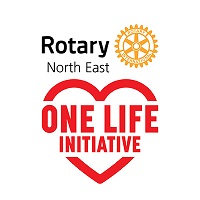Rotary North East 'One Life Initiative'
This project is aimed at increasing the number and availability of 'Community Public Access Defibrillators' (cPADs) across the north-east. This equipment has the potential to save the lives of those experiencing a cardiac arrest.

Rotary North East 'One Life Initiative
2021/2022
This project is aimed at increasing the number and availability of 'Community Public Access Defibrillators' (cPADs) across the north-east. This equipment has the potential to save the lives of those experiencing a cardiac arrest.
Why are community defibrillators important?
A cPAD is a defibrillator that is available to members of the public, 24 hours a day, to use in the case of a person who is having a cardiac arrest. In the north-east, only 8.7% of patients who had resuscitation attempted on them survived to be discharged from hospital. The key to improving the chance of survival is early CPR and early access to a defibrillator. Studies have shown that a shock given within 3 to 5 minutes can produce survival rates between 50 - 70%. For every minute it takes for the defibrillator to reach someone and deliver a shock, their chances of survival reduce by up to 10%. Whilst this equipment is carried on ambulances, having one available in the community means that it can be used in the first few vital minutes following a cardiac arrest.
Our plans
Working in consultation with the North East Ambulance Service our team hope that the availability of this equipment can be increased across the towns and villages throughout our District. Postcode areas have been identified where there is deemed to be a particularly higher need for a cPAD based on the number of cardiac arrests and the population demographics.
See current cPAD location map (select Charitable v1 to highlight areas of 'higher need)'
Please note that in the event of someone experiencing a cardiac arrest the NEAS Control will only send a person to collect a defibrillator if it is within 500 metres of the incident. This should be considered when determining your location for new equipment. The cPAD interactive map may show a defibrillator(s) in a town or village, however, these may well not give that town or village adequate cover.
You may be aware of a location that already has a defibrillator inside the premises. Would they consider having an external cabinet fitted thus making the device available for public use 24 hours a day?
The project team is available to offer support and advice to Rotary club(s) and work with them and their communities to develop plans to install equipment at appropriate sites.
Cost
The Project Team has negotiated a discounted price of £1398 (incl Vat) for an iPAD SP1 Defibrillator and Defibsafe2 secure Coded lock outside cabinet.
The cabinet requires an electrical supply to maintain an operating temperature during cold spells This is estimated to cost no more than £5 or £6 per year.
Other on-going costs would be the replacement of the defibrillator pads every 2 years or when used (£35-40) and replacement of the battery every 4 to 5 years (£176)
Guardians
When determining a location for a cPAD please remember that 2 persons are needed to act as 'Guardians'. One would normally be the host of the equipment and their role is to carry out very basic weekly checks of the defibrillator and cabinet and to email confirmation to NEAS that the equipment is operationally functional and available. He/she will also be notified by NEAS in the event that the equipment has been deployed.
Funding
The relevant Rotary Club(s) will commence fund-raising and/or seek grant funding within their own communities. The cPAD(s) will be a public resource and community co-operation, support and ownership of their equipment should be promoted.
Familiarisation
Although a person does not need to be trained to operate a defibrillator, sessions can be arranged to offer familiarisation in their use.
So what do you need to do?
1. Work with your communities to identify area(s) and site(s) for defibrillator cabinet(s)
2. Confirm local person(s) to act as ‘Guardians’ to carry out routine weekly checks
3. Secure funding and make purchase(s)
4. Install the equipment, register with NEAS, ensure publicity
5. Familiarisation training (anyone can use the defibrillator, training is preferable but not essential)
The Rotary North East 'One LIfe Initiative' Team
Philip Hopps, District Community Service Team Lead, Rotary Washington Forge
Tom Sharples, Rotary Durham Elvet
Barbara Broadbelt, District Governor, Rotary Durham Elvet
Just ask us if you would like one of us to talk to your club members about the project
e.mail: rotarynedefibs@outlook.com
Would like to donate to the project? See Go Fund Me
 @rotaryneonelife
@rotaryneonelife
Download pdf documents
About the Rotary North East 'One Life Initiative'
cPADs - Considerations and General Information
RNE- cPAD Step Process
back to page above this...
Community & Vocational Service
back Community & Vocational Service
